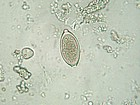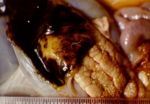Difference between revisions of "Trichuris"
Jump to navigation
Jump to search
| (25 intermediate revisions by 2 users not shown) | |||
| Line 1: | Line 1: | ||
| − | {{ | + | {{unfinished}} |
| − | |||
| − | |||
| − | |||
| − | |||
| − | |||
| − | |||
| − | |||
| − | |||
| − | |||
| − | |||
| − | |||
| − | |||
| − | |||
| − | |||
| − | |||
| − | |||
| − | |||
| − | |||
| + | * Also known as the "'''whipworm'''" | ||
| + | ** Derives its name from its characteristic whiplike shape | ||
[[Image:Trichuris ovis sheep.jpg|thumb|right|150px|''Trichuris ovis'' from sheep faeces - Joaquim Castellà Veterinary Parasitology Universitat Autònoma de Barcelona]] | [[Image:Trichuris ovis sheep.jpg|thumb|right|150px|''Trichuris ovis'' from sheep faeces - Joaquim Castellà Veterinary Parasitology Universitat Autònoma de Barcelona]] | ||
[[Image:Trichuris ovis.jpg|thumb|right|150px|''Trichuris ovis'' in caecum - Supplied by Biomed Image Archive]] | [[Image:Trichuris ovis.jpg|thumb|right|150px|''Trichuris ovis'' in caecum - Supplied by Biomed Image Archive]] | ||
[[Image:Trichuris vulpis.jpg|thumb|right|150px|''Trichuris vulpis'' - Courtesy of the Laboratory of Parasitology, University of Pennsylvania School of Veterinary Medicine]] | [[Image:Trichuris vulpis.jpg|thumb|right|150px|''Trichuris vulpis'' - Courtesy of the Laboratory of Parasitology, University of Pennsylvania School of Veterinary Medicine]] | ||
| − | == | + | == ''Trichuris'' Species == |
| − | + | *The whipworms have a stout posterior end and a long narrow neck, which is superficially inserted into the caecal mucosa | |
| + | *Eggs are brown, barrel-shaped, with a plug at either end, and can survive for up to 12 years | ||
| + | *The infective stage is the embryonated egg. | ||
| + | *The life-cycle is direct | ||
| + | *After the egg is swallowed, the larva initially forms a mucosal nodule before emerging into the lumen | ||
| − | == | + | ==Species== |
| − | ''' | + | |
| − | + | * '''''Trichuris vulpis''''' - dog whipworm | |
| − | ''' | + | * '''''Trichuris campanula''''' (Europe) and ''Trichuris serrata'' (North America) - cat whipworms. |
| − | + | ** Are quite rare. | |
| − | ''' | + | * '''''Trichuris suis''''' - pig whipworm |
| − | |||
==Life Cycle== | ==Life Cycle== | ||
| − | |||
| − | |||
| − | |||
| − | |||
| − | |||
| − | |||
| − | |||
| − | |||
| − | |||
| − | |||
| − | |||
| − | |||
| − | |||
| − | |||
| − | |||
| − | |||
| − | |||
| − | |||
| − | |||
| + | * Faeco-oral spread | ||
| + | * Eggs become infective after 10-14 days in soil. | ||
| + | * Larvae hatch in small intestine. | ||
| + | ** Grow and moult. | ||
| + | * Finally take up resisidence in large intestine. | ||
| + | ** I.e. NO tissue migratory phase. | ||
| − | + | ==Clinical== | |
| − | + | * Adult buries its thin anterior half into the intestinal mucosa and feeds on tissue secretions (not blood). | |
| + | ** The caecum and colon are the most commonly infected sites. | ||
| + | ** Causes eosinophilia. | ||
| + | *Signs may include: | ||
| + | ** Diarrhoea | ||
| + | *** [[Intestines Catarrhal Enteritis - Pathology#Parasites|Catarrhal enteritis]] | ||
| + | ** Anemia | ||
| + | ** Dehydration | ||
[[Category:Trichinelloidea]] | [[Category:Trichinelloidea]] | ||
| − | |||
| − | |||
| − | |||
| − | |||
Revision as of 11:12, 26 April 2010
| This article is still under construction. |
- Also known as the "whipworm"
- Derives its name from its characteristic whiplike shape
Trichuris Species
- The whipworms have a stout posterior end and a long narrow neck, which is superficially inserted into the caecal mucosa
- Eggs are brown, barrel-shaped, with a plug at either end, and can survive for up to 12 years
- The infective stage is the embryonated egg.
- The life-cycle is direct
- After the egg is swallowed, the larva initially forms a mucosal nodule before emerging into the lumen
Species
- Trichuris vulpis - dog whipworm
- Trichuris campanula (Europe) and Trichuris serrata (North America) - cat whipworms.
- Are quite rare.
- Trichuris suis - pig whipworm
Life Cycle
- Faeco-oral spread
- Eggs become infective after 10-14 days in soil.
- Larvae hatch in small intestine.
- Grow and moult.
- Finally take up resisidence in large intestine.
- I.e. NO tissue migratory phase.
Clinical
- Adult buries its thin anterior half into the intestinal mucosa and feeds on tissue secretions (not blood).
- The caecum and colon are the most commonly infected sites.
- Causes eosinophilia.
- Signs may include:
- Diarrhoea
- Anemia
- Dehydration


